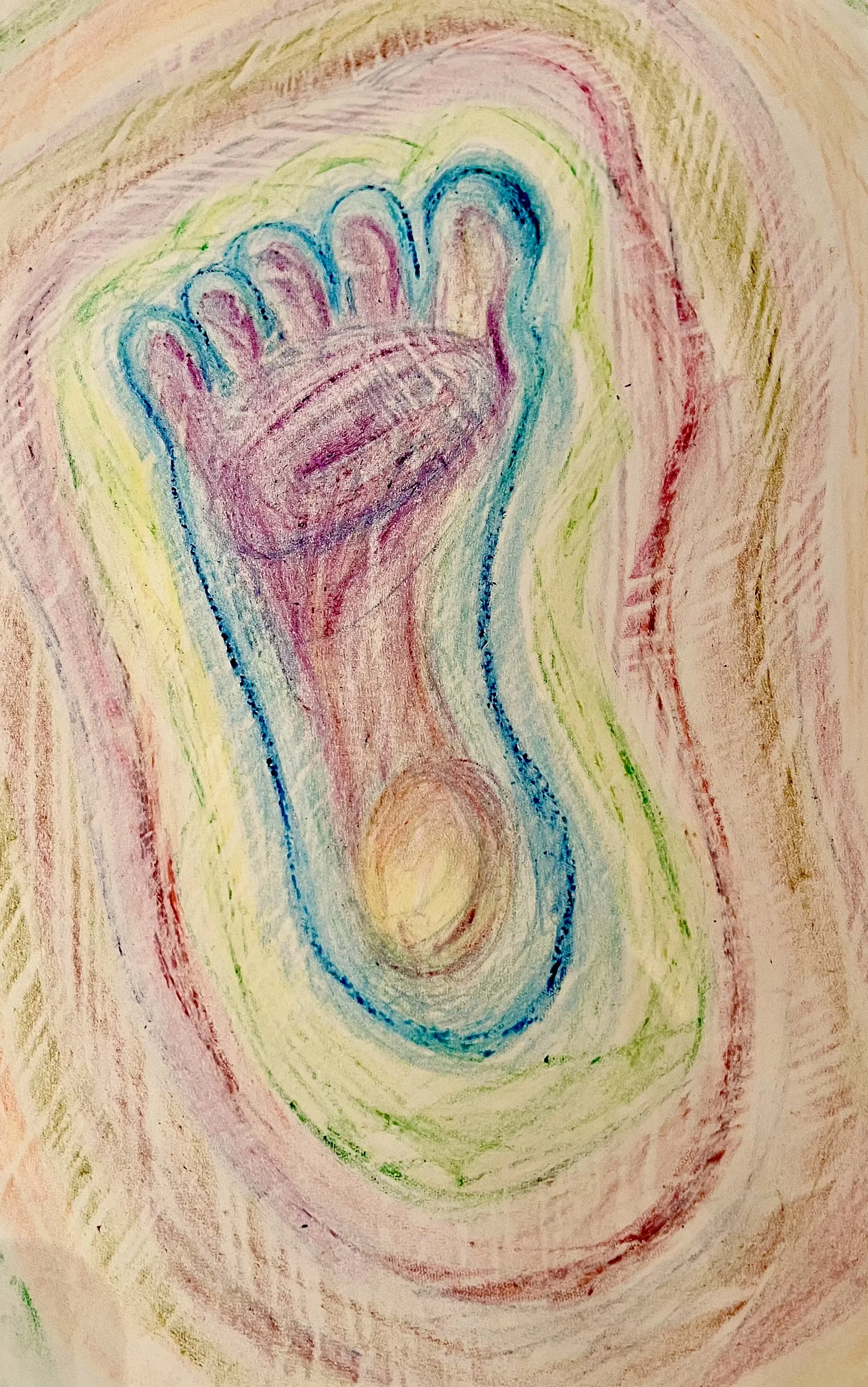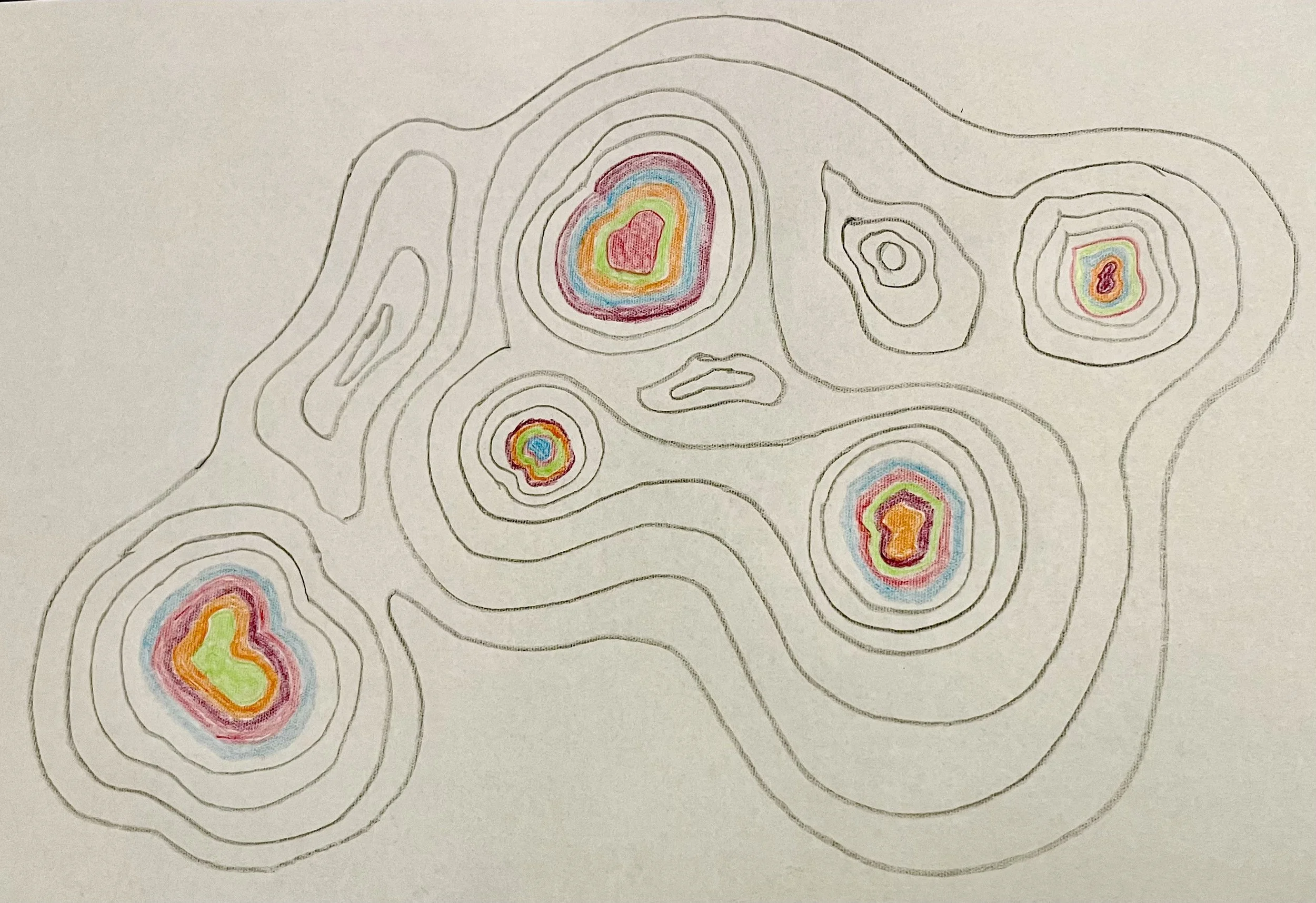the movement
honor ancestors, serve descendants, nourish all
Image: Klye’s artistic rendering of Pancha Kosha
We are pancha kosha
I am blessed with loved ones who will participate in random creative endeavors even at the end of a long day of work. With our empty dinner dishes pushed aside we spread out a collection of color pencils and crayons to set about our artistic exploration of the Pancha Kosha. On this particular art adventure, I’m excited about using the outline of a footprint as a springboard. I’ve shared our three versions / visions of the ancient yogic concept of humanity. I invite you to play with your own artistic interpretation of the pancha kosha notion.
The roots of yoga teach us that we humans are multi-dimensional. The pancha kosha (five sheaths) concept taught in the Upanishads (ancient texts) explains we are body, breath, mind, wisdom, and spirit.
Detailed in the Taittireya Upanishad the five major sheaths of existence:
· Annamaya Kosha (physical matter)
· Pranamaya Kosha (vital life force)
· Manomaya Kosha (mind)
· Vijnanamaya Kosha (discerning faculty)
· Anadamaya Kohsa (most subtle aspect of our existence, a state of bliss)
All five sheaths interrelate. Each can affect the others. You may have heard something akin to “the practice of yoga is to quiet the mind.” The pancha kosha concept helps us to see (for example) that handling our mind skillfully allows for balance in breath and ease in body. In a similar sense, we can use the breath to calm the mind. Try it yourself as a five minute experiment to watch your mind and breath. You may notice a change in the depth and duration of the breath. You may notice a shift in the activity of the mind. I’m always curious to hear what folks witness from their own experience. Please let me know if you wish to share.
5 minute practice
Take a moment to notice how you feel (i.e. establish your baseline).
Set a timer for 5 minutes.
While you are inhaling say in your mind “I am breathing in.”
While you are exhaling say in your mind “I am breathing out.”
If you are able to do this with your eyes closed to help you rest your awareness on your breath, please do. If you need to keep your eyes open simply relax your gaze.
After the 5 minute practice again simply notice how you feel (i.e. observe any difference).
In the Yoga Sutras, Patanjali offers us this clear and concise aphorism, ‘Yogas chitta vritti nirodhah’ (sutra 1.2) that can translate to ‘Yoga is the cessation of the fluctuations of the mind.’ When I began the practice 26 years ago, I grasped the concept intellectually, but I had no idea what it really meant to embody this. By the grace of many teachers, fellow practitioners, and students on this wild and wonderful journey I am realizing that yoga is a practice towards freedom. Freedom from physical disease. Freedom from mental anguish. Freedom from repeatedly making the same mistakes. The ancient texts specify the path of yoga is to free ourselves from the misperceptions and habits that bind us to anger, hate, jealousy, and greed. As I work through and shed attachment to these obstacles on the path towards liberation, I experience deeper states of contentment, harmony, and inner peace.
It feels important to iterate here that I am an average human being. These techniques are available to anyone, anywhere, any time. All that is required is the pancha kosha; body, breath, mind, intellect, spirit. Simply by being born human you have all that is needed for the path to liberation from an excessive ego that clings to avarice and envy. The true delight of humanity is that we are all human and we are all different! I invite you to take a moment to go beyond the obvious diversity of nationality, race, language, socioeconomic status, and personal history. Consider that your bone density is different than mine. Your resting heart rate is different than your neighbors. Your learning style, memory, sense of self, likes, and dislikes are all unique to you. Now recall that all humans share in the commonality of pancha kosha, therefore the great good news is our human diversity enables us to learn from each other.
Image: outline of my big ol’ left foot and artistic rendering of Pancha Kosha
April 2025
Image: Casey’s artistic rendering of Pancha Kosha
While breaking bread and coloring our pancha koshas, Casey, Kyle, and I told stories of navigating life in the recent months and years. Neither man would claim to be on the path of yoga and yet I felt as if I was in a master class of how to handle the ‘chitta vrittis’ (the fluctuations of the mind that bind us to unhealthy habits and misperceptions). The roots of yoga further teach us we (human beings) are inter-related not only to each other but to all of existence. That means, know it or not, like it or not, we each affect each other. Yoga invites us to realize as we grow and establish our individual selves in the state of inner peace, to show up in our communities and offer that same peace to our collective.
I was deeply moved to see our friend Casey’s rendering of the pancha kosha (above). As I gazed at the topographic looking lines, they reminded me of ripples in a pond overlapping and merging. Casey is almost a generation younger than me and grew up in a completely different cultural setting. In the treasured few times we have spent together I have learned lasting lessons on courage and compassion (which unbeknownst to Casey are pillars of Yoga) from him.
As we packed away the crayons and color pencils, I asked Kyle and Casey for their permission to share these renderings in a newsletter. With their gracious agreement we knew it was time to say our goodbyes. Casey was catching a flight home having just completed a Secret Service duty in our area. Kyle had to pack his bag to fly out on a Homeland Security mission overseas. Nourished by our shared experience it was time for me to prepare for the classes I would teach in the morning. Melancholy in recognition that our three paths would diverge I knew to lean into gratitude. Grateful that the lifelong cultivation of inner equilibrium in each man would soon be in service to folks far and wide.
As I walk into the final months of grad school (Master of Science in Yoga Therapy) I am often reminded that the therapeutic application of the yoga is based on the foundation of the pancha kosha. There is growing body of scientific research showing we humans reap lasting health benefits with the continuous cultivation of inner peace. I posit that it is equally important to establish and maintain inner harmony to benefit our fellow beings. No matter the situations and circumstances we find ourselves in, we can bring balance and the possibility of peace within ourselves and to the collective.
Every step on the path toward freedom is one step further away from greed and hatred. Whatever path you are on (and there are many), I am cheering for you. Thank you for doing the inner work and showing up in community. I know it is tough work, and I know it is absolutely necessary, especially now. We need your whole being, your glorious pancha kosha on this planet. Please keep on your path towards peace.



